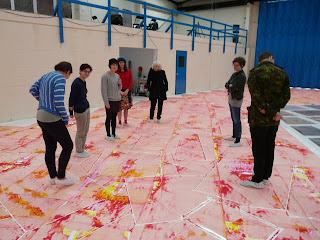October Open Crit
In our recent open crits, we have been experimenting with how we document the discussions which take place. For our July open crit, we invited the 3 members who presented their work to write something about their particular experience of the crit, if and how they found it useful, and what they intended to do as a result. At last week's crit, we passed a laptop between us and notated various thoughts and ideas that occurred to us in response to the dialogue and the work being presented. This is what was written:
Constrained by the tools, constrained by language, not
enough letters to make a full alphabet..
Decisions about how to present them in Scarborough.. is it a
postcard book.. should it have a ribbon around.. how much should it be sold
for..
New text written (coming from past work and experience) came
in reposnse to the photography. – a new
age of poetry. Presented books without
photographs, as unfinished- but they work as simple poetry books too.
Few words could make images more complete. It’s a kind of
new poetry. Text and pictures could work well together.
Made with constraints of materials and knowledge of process
they are almost perfect replications of postcard books in form and feel. Ready
to tear and share.
Condensed versions of longer chunks of text and meaning,
stripped down to their bare essence yet still redolent of something bigger (can
be read with or without accompanying images). Remind me of Alec Finlay’s
Mesoteric poem series and installation Propagator
at Yorkshire Sculpture Park, short plant-themed poems branching out from a stem
of letters to reveal an inner meaning of the subject under discussing.
Photo albums, instead of annotating photographs with text,
annotating text with photographs. Handmade/precious/editioned/throwaway. Creation
of work with limitations. I like the idea of multiple endpoints for one
project, each book a different form of the same idea. But how does this relate
to the distillation process. Will the project end?
The words are both concrete in their form and float as
words. With the images there is
something like the anchor and relay that Roland Barthes talks about that
possibly constrains. Words alone resonate poetically. Remniscent of early conceptuaists like Joseph
Kosuth
Devalued
Jenny – charcoal drawings demolished with a wrecking ball –
dust to dust – drawing something that becomes a ruin –
What really happens when you are drawing – there is a moment
when you can’t see – a leap of afaith –
The tiny space at the very instant of drawing. presence, perception,
absence of sight and memory: Derrida.
The link between blindness and the gesture of the hand
(linked with the act of drawing in which we have a ‘blind’ moment) The gesture
reaches out and also implores people.
Ruin in the portrait – attempt to make ones self ‘selfies’
which you can never achieve, it is already a ruin. They are a reminder that our
sense of self is dependent on everything that is other to us.
Response to ruin: passivity, weeping – in history of art
women often pictured crying, as blind people are pictured gesturing.
Imploration rather than vision, in both cases?
Drawing is not only the transcription of what we see.
Drawing could be thought as a process that makes visible the gap between mind
and sight, between seeing and knowing.
Is the context of the work being transcribed onto the walls
of an art school important?
Drawing as absence – drawing starts as an absence, but this
gap is never fully filled – there is impossibility of ever attaining
completion, and of fully knowing/closing the gap. Ties into idea of ruin –
something already has something of its future ruin in it, even as it is being
created.


